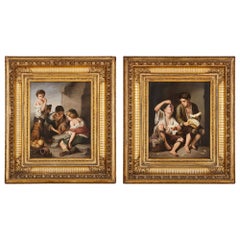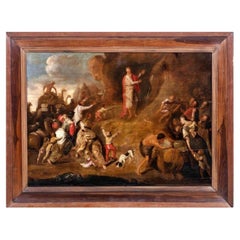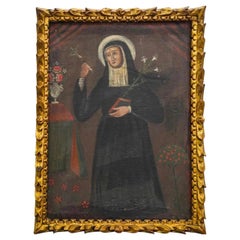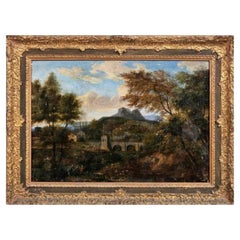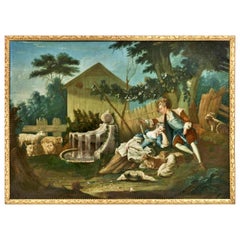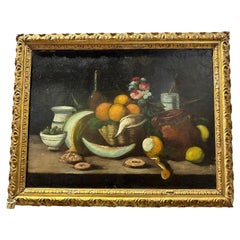Baroque Paintings
The decadence of the Baroque style, in which ornate furnishings were layered against paneled walls, painted ceilings, stately chandeliers and, above all, gilding, expressed the power of the church and monarchy through design that celebrated excess. And its influence was omnipresent — antique Baroque furniture was created in the first design style that truly had a global impact.
Theatrical and lavish, Baroque was prevalent across Europe from the 17th to mid-18th century and spread around the world through colonialism, including in Asia, Africa and the Americas. While Baroque originated in Italy and achieved some of its most fantastic forms in the late-period Roman Baroque, it was adapted to meet the tastes and materials in each region. French Baroque furniture informed Louis XIV style and added drama to Versailles. In Spain, the Baroque movement influenced the elaborate Churrigueresque style in which architecture was dripping with ornamental details. In South German Baroque, furniture was made with bold geometric patterns.
Compared to Renaissance furniture, which was more subdued in its proportions, Baroque furniture was extravagant in all aspects, from its shape to its materials.
Allegorical and mythical figures were often sculpted in the wood, along with motifs like scrolling floral forms and acanthus leaves that gave the impression of tangles of dense foliage. Novel techniques and materials such as marquetry, gesso and lacquer — which were used with exotic woods and were employed by cabinetmakers such as André-Charles Boulle, Gerrit Jensen and James Moore — reflected the growth of international trade. Baroque furniture characteristics include a range of decorative elements — a single furnishing could feature everything from carved gilded wood to gilt bronze, lending chairs, mirrors, console tables and other pieces a sense of motion.
Find a collection of authentic antique Baroque tables, lighting, decorative objects and other furniture on 1stDibs.
Late 19th Century German Antique Baroque Paintings
Porcelain, Giltwood
17th Century Dutch Antique Baroque Paintings
Paint
18th Century Italian Antique Baroque Paintings
Canvas, Wood
Mid-18th Century Italian Antique Baroque Paintings
Paint
Early 18th Century French Antique Baroque Paintings
Paint
17th Century Spanish Antique Baroque Paintings
Paint
17th Century Dutch Antique Baroque Paintings
Paint
Late 17th Century Italian Antique Baroque Paintings
Canvas, Oak
19th Century French Antique Baroque Paintings
Paint
17th Century Dutch Antique Baroque Paintings
Paint
18th Century Dutch Antique Baroque Paintings
Paint
Early 19th Century Italian Antique Baroque Paintings
Paint
Mid-17th Century Italian Antique Baroque Paintings
Canvas, Giltwood
Early 18th Century Italian Antique Baroque Paintings
Paint
19th Century French Antique Baroque Paintings
Paint
17th Century Italian Antique Baroque Paintings
Paint
18th Century Italian Antique Baroque Paintings
Paint
Early 18th Century English Antique Baroque Paintings
Canvas, Wood, Paint
Late 19th Century Italian Antique Baroque Paintings
Canvas, Giltwood
19th Century Italian Antique Baroque Paintings
Gesso, Canvas, Wood
16th Century Spanish Antique Baroque Paintings
Wood
18th Century Austrian Antique Baroque Paintings
Canvas, Wood
17th Century Italian Antique Baroque Paintings
Paint
Late 18th Century French Antique Baroque Paintings
Canvas
20th Century European Baroque Paintings
Canvas, Giltwood
17th Century French Antique Baroque Paintings
Canvas, Giltwood
Mid-19th Century Italian Antique Baroque Paintings
Walnut
Early 1900s Italian Antique Baroque Paintings
Canvas, Giltwood
Late 17th Century Italian Antique Baroque Paintings
Canvas
1790s Italian Antique Baroque Paintings
Canvas
Early 1900s Italian Antique Baroque Paintings
Canvas, Giltwood
Late 17th Century Italian Antique Baroque Paintings
Canvas
Late 17th Century Spanish Antique Baroque Paintings
Copper, Other
Late 19th Century French Antique Baroque Paintings
Copper
19th Century Italian Antique Baroque Paintings
Giltwood, Paint
1870s German Antique Baroque Paintings
Porcelain
Early 18th Century Italian Antique Baroque Paintings
Canvas, Wood
18th Century Finnish Antique Baroque Paintings
Glass, Giltwood, Paint
Mid-17th Century Italian Antique Baroque Paintings
Wood, Canvas
1890s English Antique Baroque Paintings
Canvas, Giltwood
18th Century European Antique Baroque Paintings
Other
Early 1900s Italian Antique Baroque Paintings
Linen, Wood
1920s American Vintage Baroque Paintings
Canvas, Giltwood
Late 18th Century British Antique Baroque Paintings
Canvas, Wood
19th Century Spanish Antique Baroque Paintings
Paint
Late 18th Century French Antique Baroque Paintings
Canvas
18th Century French Antique Baroque Paintings
Gold Leaf
1670s Italian Antique Baroque Paintings
Canvas
18th Century Spanish Antique Baroque Paintings
Paint
18th Century German Antique Baroque Paintings
Canvas, Glass, Wood
Late 17th Century Italian Antique Baroque Paintings
Wood, Paint
19th Century Italian Antique Baroque Paintings
Paint
19th Century Italian Antique Baroque Paintings
Wood
1930s European Vintage Baroque Paintings
Plywood, Wood, Paint
Late 18th Century Italian Antique Baroque Paintings
Canvas, Giltwood
Late 17th Century European Antique Baroque Paintings
Tapestry, Wool, Silk
1860s German Antique Baroque Paintings
Porcelain
18th Century Italian Antique Baroque Paintings
Giltwood, Paint
